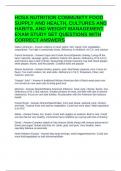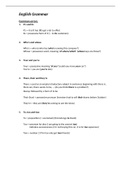HOSA NUTRITION COMMUNITY FOOD
SUPPLY AND HEALTH, CULTURES AND
HABITS, AND WEIGHT MANAGEMENT
EXAM STUDY SET QUESTIONS WITH
CORRECT ANSWERS
Native American - Answer-reliance on land: game, fish, maize, fruit, vegetables,
soups/dried. Too high in sweet/salty foods, deficiency in riboflavin, vit C,A, and calcium
French American - Answer-Cajun and Creole French/Spanish cooking. Living off the
land: craw-fish, sausage, game, seafood. Calorie rich sauces. Deficiency of Vit A,C,D
and Calcium due to lack of fruits. Seasonings include Cayenne, bay leaf, black pepper,
white pepper, thyme, and file powder. Crawfish boils are popular
African American - Answer-Grains, greens, pork, fried foods, peanuts, corn. Focus on
flavor. Too much sodium, fat, and carbs. Deficiency in Vit C, Potassium, Fiber, and
Calcium, and Iron
"Hoppin' John" - Answer-A traditional African American dish of black-eyed peas over
rice served on new years day to bring good luck
Mexican - Answer-Spanish/Native American influence. Goat, pork, cheese, beans, rice.
Deficiency of Vit C and calcium. Smaller portions of meat, and little milk due to lactose
intolerance. Focus on corn and tortillas. Acculturation with the American diet reduces
health
Puerto Rican - Answer-African/Spain/Indian, Corn and wheat, seafood, pork, chicken,
and beef. Tropical fruits and starchy vegetables. Could use more dairy. Main population
is in NYC
Italian - Answer-Pasta, rice, beans. Fruits and veggies w/ seafood. Beef is rare. Could
use less fat but very healthy. Commonly have mealtime as a group with lots of sharing
Greek - Answer-Complex salads w/ feta cheese (white sheep milk cheese preserved in
brine) and yogurt. Bread and olive oil. Lamb, goat, and pork. Very healthy. Have
specialty baklava occasionally
North-Western Europe - Answer-Big meat servings, small veggies/starches. Could use
more fruit/vegetables to add vit/minerals/fiber
,Central Europe - Answer-Eggs and dairy focus. Varied meats w/
cabbage/carrots/potatoes. Could use less fat and more vegetable variety
Middle Eastern - Answer-Lamb w/ pita/flat breads. Desserts are fruit. Dairy and
legumes. Could use more vegetables for vit/minerals/fiber
Chinese - Answer-Rice, Soybeans, barley, wheat, and millet. Lots of veggies and frying
oils. Protein from seafood, eggs, pork, chicken, beef, and tofu. too much MSG/Sodium
and too little calcium. Try not to rely on refrigeration due to beliefs of diminished flavor,
uses fresh foods. Traditional beverage is unsweetened green tea
Japanese - Answer-Fresh ingredients, veggies and protein from seafood/chicken. Many
seasonings. Could use more fresh fruit. Many soups and focus on seafood
South-East Asian - Answer-Vegetables, noodles, and rice. Fish is main meat. Not very
diverse. Eat their rice plain from other foods
Indian - Answer-Vegetarianism and respect of cows. Lentils, beans, and dairy. Northern
focus on wheat and Southern focus on rice. Potential lack of calcium
Somalian - Answer-No pork, lots of liver. Many fruits and breads. Danger of high
cholesterol and calcium deficiency
Haitian - Answer-Rice, corn, millet, yam, beans. Only rich can afford meat and seafood.
Usually cook w/ pig-fat for flavor, tropical fruits. Malnutrition is concern for poor
Korean - Answer-Rice, beans, and millet, mostly non-red meats like chicken/seafood.
Kimchi and spicy/salty sauces. Fruits as dessert
Dominican Republican - Answer-Spanish/Taino Indian. Chicken, goat, and seafood.
Smoothies and no spicy food. Adequate nutrition due to variety
Burmese - Answer-Large variety of fruits and veggies. pork, beef, lamb, and chicken.
Rice and noodles. Adequate nutrition due to variety
Jewish - Answer-Kosher foods. Must have proper slaughtering of animals, no cooking
on Passover, prescribed fasting days. No dairy and meat together
Roman Catholic - Answer-Meat not allowed on Ash Wednesday and good Friday
Eastern Orthodox - Answer-Meat restricted on Wednesdays and Fridays during lent
Orthodox Judaism - Answer-strict interpretation of dietary laws
Conservative Judaism - Answer-less strict observance of dietary laws
, Reform Judaism - Answer-limited observance of dietary laws and less ceremonial
emphasis
Rules of Kashrut - Answer-basic body of dietary laws for Jews, established in the Torah
Kosher - Answer-means "fit/proper" in Hebrew
Kosher meat standards - Answer-cloven hooves and chew their cud. No birds of prey,
rabbits, or pork. Meat must be thoroughly cleaned of blood
Kosher egg standards - Answer-no eggs with a bloodspot
Kosher seafood standards - Answer-fish must have fins and scales. shellfish and
crustaceans are avoided
Kosher meat and milk standards - Answer-milk and meat cannot be consumed at the
same time
Seventh Day Adventist - Answer-Lacto-Ovo-vegetarians. coffee/tea/alcohol harmful
Mormon - Answer-No coffee/tea/alcohol
Islamic - Answer-No pork, no alcohol, and no birds of prey. Slaughtering laws.
Restricted eating/drinking during the day during Ramadan
Bulgur - Answer-A Middle Eastern dish consisting of partially cooked and dried cracked
wheat
Falafel - Answer-A Middle Eastern dish consisting of a seasoned paste of ground,
soaked beans formed into shapes and fried
Fatayeh - Answer-A Middle Eastern dish consisting of a snack similar to pizza with
cheese, meat or spinach
Kibbeh - Answer-A Middle Eastern dish consisting of cracked wheat filled with small
pieces of lamb and fried
Pilaf - Answer-A Middle Eastern dish consisting of sauteed and seasoned burger or rice
that is steamed in a bouillon, sometimes with meat
Pita - Answer-A Middle Eastern dish consisting of a flat circular bread torn or cut into
peaces and stuffed with fillings or used as a scoop for hummus made from chickpeas
Ramadan - Answer-a 30-day period of daylight fasting
Iftar - Answer-"evening breakfast" for Muslims during Ramadan





